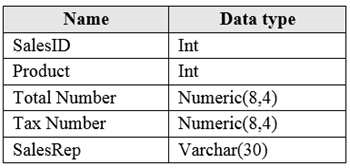Download Microsoft.DP-300.PrepAway.2021-04-16.39q.tqb
| Vendor: | Microsoft |
| Exam Code: | DP-300 |
| Exam Name: | Administering Relational Databases on Microsoft Azure |
| Date: | Apr 16, 2021 |
| File Size: | 2 MB |
Demo Questions
Question 1
You have an Azure SQL database that contains a table named factSales. FactSales contains the columns shown in the following table.

FactSales has 6 billion rows and is loaded nightly by using a batch process.Which type of compression provides the greatest space reduction for the database?
- page compression
- row compression
- columnstore compression
- columnstore archival compression
Correct answer: D
Explanation:
Explanation: Columnstore tables and indexes are always stored with columnstore compression. You can further reduce the size of columnstore data by configuring an additional compression called archival compression.Note: Columnstore — The columnstore index is also logically organized as a table with rows and columns, but the data is physically stored in a column-wise data format.Incorrect Answers:B: Rowstore — The rowstore index is the traditional style that has been around since the initial release of SQL Server.For rowstore tables and indexes, use the data compression feature to help reduce the size of the database.Reference:https://docs.microsoft.com/en-us/sql/relational-databases/data-compression/data-compression Explanation:
Columnstore tables and indexes are always stored with columnstore compression. You can further reduce the size of columnstore data by configuring an additional compression called archival compression.
Note: Columnstore — The columnstore index is also logically organized as a table with rows and columns, but the data is physically stored in a column-wise data format.
Incorrect Answers:
B: Rowstore — The rowstore index is the traditional style that has been around since the initial release of SQL Server.
For rowstore tables and indexes, use the data compression feature to help reduce the size of the database.
Reference:
https://docs.microsoft.com/en-us/sql/relational-databases/data-compression/data-compression
Question 2
You have a Microsoft SQL Server 2019 instance in an on-premises datacenter. The instance contains a 4-TB database named DB1.
You plan to migrate DB1 to an Azure SQL Database managed instance.
What should you use to minimize downtime and data loss during the migration?
- distributed availability groups
- database mirroring
- log shipping
- Database Migration Assistant
Correct answer: A
Explanation:
The Data Migration Assistant (DMA) helps you upgrade to a modern data platform by detecting compatibility issues that can impact database functionality in your new version of SQL Server or Azure SQL Database. DMA recommends performance and reliability improvements for your target environment and allows you to move your schema, data, and uncontained objects from your source server to your target server. Note: SQL Managed Instance supports the following database migration options (currently these are the only supported migration methods):Azure Database Migration Service - migration with near-zero downtime. Native RESTORE DATABASE FROM URL - uses native backups from SQL Server and requires some downtime. Reference:https://docs.microsoft.com/en-us/sql/dma/dma-overview The Data Migration Assistant (DMA) helps you upgrade to a modern data platform by detecting compatibility issues that can impact database functionality in your new version of SQL Server or Azure SQL Database.
DMA recommends performance and reliability improvements for your target environment and allows you to move your schema, data, and uncontained objects from your source server to your target server.
Note: SQL Managed Instance supports the following database migration options (currently these are the only supported migration methods):
- Azure Database Migration Service - migration with near-zero downtime.
- Native RESTORE DATABASE FROM URL - uses native backups from SQL Server and requires some downtime.
Reference:
https://docs.microsoft.com/en-us/sql/dma/dma-overview
Question 3
You have an on-premises Microsoft SQL Server 2016 server named Server1 that contains a database named DB1.
You need to perform an online migration of DB1 to an Azure SQL Database managed instance by using Azure Database Migration Service.
How should you configure the backup of DB1? To answer, select the appropriate options in the answer area.
NOTE: Each correct selection is worth one point.
Correct answer: To work with this question, an Exam Simulator is required.
Explanation:
Box 1: Full and log backups onlyMake sure to take every backup on a separate backup media (backup files). Azure Database Migration Service doesn't support backups that are appended to a single backup file. Take full backup and log backups to separate backup files. Box 2: WITH CHECKSUMAzure Database Migration Service uses the backup and restore method to migrate your on-premises databases to SQL Managed Instance. Azure Database Migration Service only supports backups created using checksum. Incorrect Answers:NOINIT Indicates that the backup set is appended to the specified media set, preserving existing backup sets. If a media password is defined for the media set, the password must be supplied. NOINIT is the default. UNLOAD Specifies that the tape is automatically rewound and unloaded when the backup is finished. UNLOAD is the default when a session begins. Reference:https://docs.microsoft.com/en-us/azure/dms/known-issues-azure-sql-db-managed-instance-online Box 1: Full and log backups only
Make sure to take every backup on a separate backup media (backup files). Azure Database Migration Service doesn't support backups that are appended to a single backup file. Take full backup and log backups to separate backup files.
Box 2: WITH CHECKSUM
Azure Database Migration Service uses the backup and restore method to migrate your on-premises databases to SQL Managed Instance. Azure Database Migration Service only supports backups created using checksum.
Incorrect Answers:
NOINIT
Indicates that the backup set is appended to the specified media set, preserving existing backup sets. If a media password is defined for the media set, the password must be supplied. NOINIT is the default.
UNLOAD
Specifies that the tape is automatically rewound and unloaded when the backup is finished. UNLOAD is the default when a session begins.
Reference:
https://docs.microsoft.com/en-us/azure/dms/known-issues-azure-sql-db-managed-instance-online






